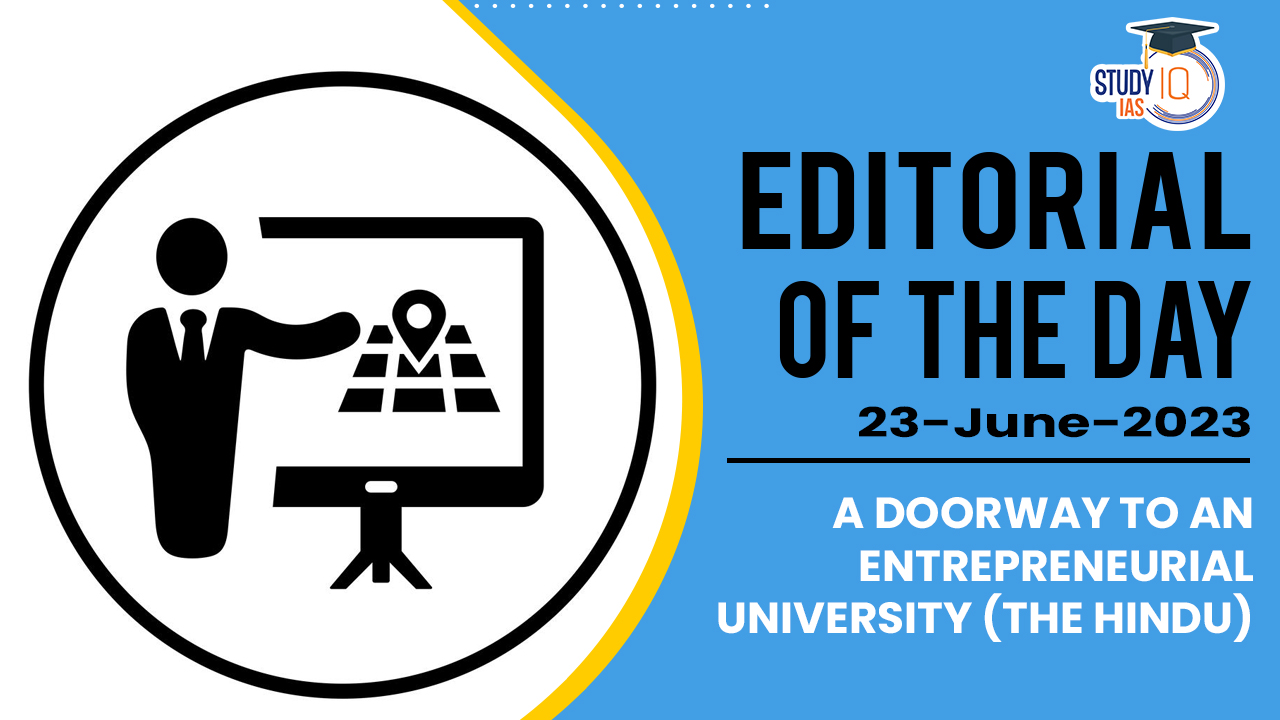Table of Contents
Context: The article discusses the concept of a “Professor of Practice” and its potential to bridge the gap between academia and the professional world. It emphasizes that new knowledge often emerges from interactions between different disciplines and that collaborations between diverse players lead to the creation of novel bodies of knowledge. The article acknowledges that university systems have always recognized the importance of multidisciplinary studies. It highlights the evolution of the modern university system, which has institutionalised and scaled up research and study in various disciplines over time. Furthermore, it points out that the growth of new disciplines has given rise to numerous sub-disciplines, including Artificial Intelligence (AI) and Generative AI. Overall, the article discusses the importance of multidisciplinary studies, the evolution of the modern university system, the emergence of new disciplines and subdisciplines, and the value of collaborations between academia and industry in driving economic and intellectual growth.
A Doorway to an Entrepreneurial University Background
Higher Education in India
- The term ‘higher education’ with respect to India denotes the tertiary level education that is imparted after 12 years of schooling (10 years of primary education and 2 years of secondary education).
- India’s higher education system is the third largest in the world, next to the United States and China.
- India’s Higher Education sector has witnessed a tremendous increase in the number of Universities/University level Institutions & Colleges since independence.
- As per the All-India Survey of Higher Education (AISHE), there are 1,043 universities, 42,343 colleges and 11,779 standalone institutions.
- Out of these, almost 78.6% are in the private sector– aided or unaided colleges and only about 21% are in the Government sector.
Key findings of All India Survey on Higher Education (AISHE) 2020-2021:
| Specification | 2020-21 | Trend w.r.t 2014-15 |
| Total student enrollment: UP, Maharashtra, TN, MP, Karnataka and Rajasthan are top 6 States in terms of number of students enrolled | 4.14 crore | 21% rise |
| Female enrolment | 2.01 crore | 28% rise |
| Percentage of female enrolment to total enrolment | 49% | 4% rise |
| Gross Enrolment Ratio (GER): Percentage of students belonging to eligible age group (18-23 years) enrolled in Higher Education | 27.3 | 3-point rise |
| Gender Parity Index (GPI): Ratio of female GER to male GER | Increased from 1 in 2017-18 to 1.05 | — |
| Institutes of National Importance (INIs) | 149 | Almost doubled (75) |
| Enrolment in INIs | 61% | Increased |
| Female per 100 male faculty | 75 | Increased (63) |
Issues plaguing India’s Higher Education
- Shortage of Faculty: Colleges and universities need a sufficient number of teachers and researchers to create and disseminate knowledge. The paucity of a sufficient number of faculty members undermines the growth of India’s knowledge sector.
- There is no standing mechanism to collect the information shortage of faculties.
- Sometimes positions of faculties also remain vacant due to caste-based discrimination.
- Diversity of teachers: In central universities (CUs), 75.2% of the sanctioned SC posts, 87.3% of the ST positions and 84.7% of the OBC posts for the position of professor are lying vacant, while in the associate professor category it is 64.7%, 76.8% and 76.6% respectively.
- Shortage of PhD scholars: As per data of Lok Sabha, in 9 IITs, the acceptance rate for SC/ST/OBC PhD candidates is at or below 8%, despite all of these universities receiving hundreds of applications. The dropout trends from these premium educational institutions have been from SC/ST/OBC categories.
- Low GER: In India, currently, the gross enrolment ratio for Higher Education is less than 30%.
- Overburdening faculty: As a result of faculty shortage, professors are being overburdened. Their working hours have increased.
- Lack of Financial Resources: Public spending on education has been relatively low in India since its inception. Most states spend 2.5 to 3.2% of their GDP on education.
- Poor Quality of Education: Many private universities whose primary purpose is profit-seeking hire less qualified people in poorly paid part-time positions as faculties instead of better qualified, regular faculty members, to keep costs down.
- Commercialization: The withdrawal of the public sector has left the space open for private institutions that have turned education into a flourishing business.
- Curriculum Disparity: There is a wide gap between industry requirements and curriculum taught at colleges. This also renders graduates unemployable lacking in specific skill-sets.
- Poor Research infrastructure: India’s spending on research and development (R&D) is among the lowest in the world.
- Only 2.7% Colleges run Ph.D. programme and 35.04% Colleges run Post-Graduate Level programmes in India.
- Under-representation of Women: India’s best educational institutions rank quite poorly in women diversity. The scores have been dismal in India’s top 10 engineering institutes.
- Lack of Autonomy: The over-regulation by regulators such as UGC, MCI, which decide on aspects of standards, appointments, fee structure and curriculum has further deterred new institutions from opening campuses.
Decoding the Editorial
The article discusses the value of collaborations between academia and industry in driving economic and intellectual growth.
Entrepreneurial University:
- The statement is discussing the concept of the “entrepreneurial university” as the next phase in the evolution of universities.
- It acknowledges that there are differing views on whether universities should focus solely on being the source of new knowledge and research, or if they should also engage in commercialising their intellectual output.
- Some traditional schools of thought argue against the commercialization of university research, emphasizing the importance of universities as sources of knowledge rather than profit-making entities.
- However, new-age universities and educational entrepreneurs globally are embracing the idea of striking a balance between education and enterprise.
- Instead of engaging in a debate between these competing ideas, it is essential to create mechanisms and pathways that support research and facilitate the commercialization of research outcomes.
- By doing so, universities can harness the intellectual value of new products or processes and benefit from the economic opportunities they present.
Institutionalizing the concept of a “Professor of Practice”:
- The push by the University Grants Commission (UGC) is to institutionalize the concept of a “Professor of Practice” (PoP) in Indian higher education institutions.
- The UGC aims to enhance the quality of higher education by bringing practitioners, policymakers, skilled professionals, and others into the higher education system.
- The UGC’s initiative seeks to bridge the gap between academia and industry by introducing a new category of positions called PoPs.
- These individuals are industry experts with significant experience in their respective fields.
-
- Unlike traditional academic professors, PoPs may not be required to have a PhD or advanced research degree.
- They are appointed to faculty positions to share their practical knowledge, skills, and real-world experiences with students.
- The primary objective of the UGC’s push is to bring real-world practices and experiences into the classroom and augment the faculty resources in higher education institutions.
- By integrating industry and professional expertise into academic institutions, the UGC aims to equip graduates with the relevant skills sought after by industry and society.
- The UGC’s initiative recognizes that universities, with the influx of bright minds every year, are well-positioned to foster innovation.
- By introducing PoPs, universities can offer courses focusing on practical applications, facilitate applied learning, mentor student projects, develop industry-aligned courses, collaborate on research projects, and provide insights on converting patents into commercial products.
Significance of PoPs:
- The presence of Professors of Practice (PoPs) in universities can contribute to fostering an innovative culture and reshaping the commercial thinking of academic institutions.
- It highlights that in today’s post-knowledge societies, innovation has become the third pillar alongside teaching and research in universities.
- When an innovative culture is strongly established, it is believed that every academic within the university will have the ability to synthesise ideas and potentially create start-up enterprises.
- These university-based start-ups would not only incubate ideas but also transform them into patents and eventually into commercial products.
- The growth of such innovative ideas contributes to the development of an entrepreneurial university, where research, industry work, and academia converge.
- The author suggests that as this entrepreneurial culture strengthens, the role of PoPs may evolve, potentially leading to a new generation of “entrepreneurs in residence” within universities.
- These individuals would serve as role models and mentors, guiding bright students in creating groundbreaking ventures, similar to the creation of Google on a university campus.
Beyond the Editorial
Government Initiatives for Improving Higher Education:
- National Education Policy (NEP) 2020: It proposes various reforms in India’s higher education including technical education. NEP aims to increase the gross enrollment ratio (GER) in higher education to 50% by 2035.
- The Institute of Eminence (IoE): It is a recognition scheme under University Grants Commission (UGC) that helps empower higher educational institutions. The HRD Ministry of India grants the Institution of Eminence status to multiple universities.
- Academic institutions that can impart highest quality education, generate cutting edge research, and attract the best and the brightest from across the globe can have multiplier beneficial effects for the country.
- Rashtriya Uchchatar Shiksha Abhiyan (RUSA): It is a Centrally Sponsored Scheme (CSS) that aims at providing strategic funding to eligible state higher educational institutions.
- Education Quality Upgradation and Inclusion Programme (EQUIP): This is a five-year vision plan to improve the quality and accessibility of higher education over the next five years (2019-2024).
- Double the Gross Enrolment Ratio (GER) in higher education and resolve the geographically and socially skewed access to higher education institutions in India.
- Position at least 50 Indian institutions among the top-1000 global universities.
- Global Initiative for Academics Network (GIAN): The programme seeks to invite distinguished academicians, entrepreneurs, scientists, experts from premier institutions from across the world, to teach in the higher educational institutions in India.
- All India Survey on Higher Education (AISHE): The main objectives of the survey are to identify and capture all the institutions of higher learning in the country; and collect the data from all the higher education institutions on various aspects of higher education.


 DRDO and Air Force Successfully Test Ind...
DRDO and Air Force Successfully Test Ind...
 IB ACIO Recruitment 2025 Notification Ou...
IB ACIO Recruitment 2025 Notification Ou...





















